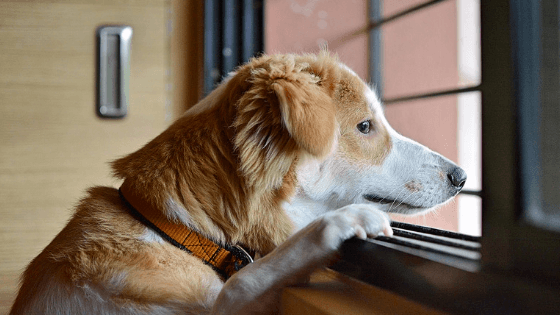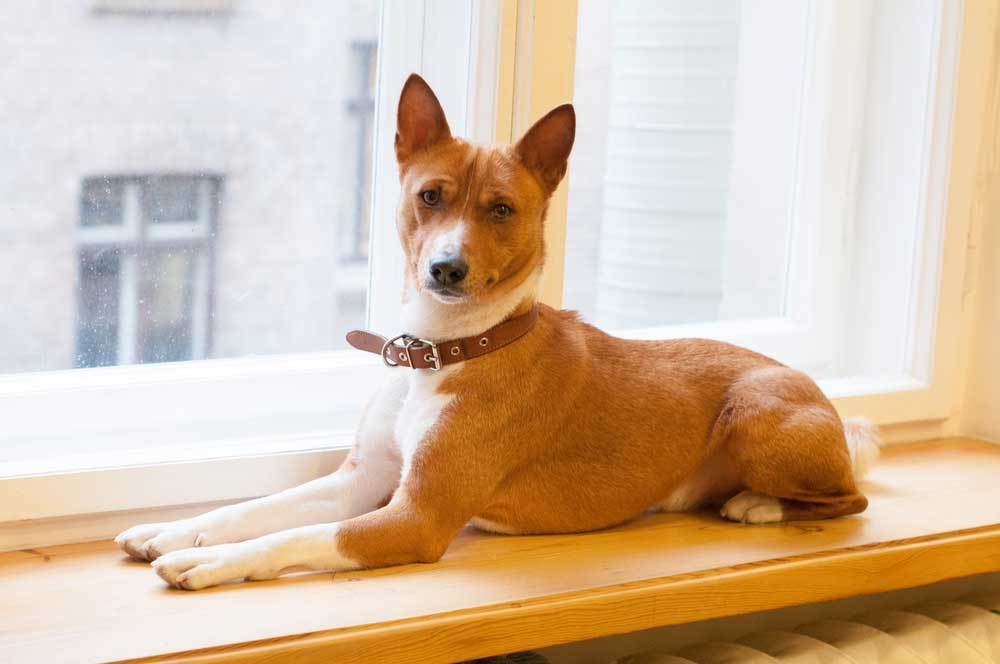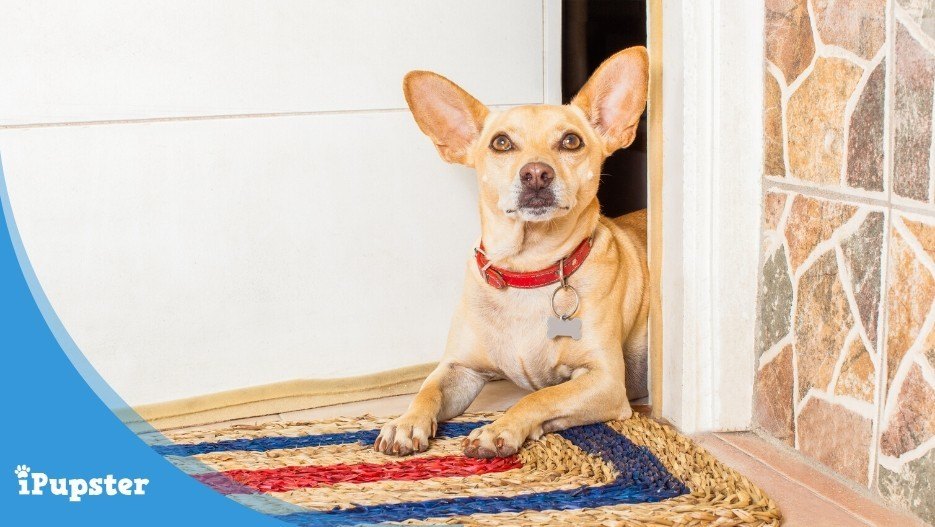Most of us, especially those with large families, relish the couple minutes of alone time we get when we go to the bathroom. So why do dogs always follow you into the bathroom?
It’s certainly uncomfortable when your dog is staring you down or vying for your affection when you’re trying to do what you need to do in there. We get it.
This handy guide explains why your dog always insists on accompanying you to the bathroom. Is it separation anxiety? Is it protection? Or is it something else altogether?
We finish off with tips on what to do if you’re just too uncomfortable having your dog in the bathroom with you.
Why Do Some Dogs Want To Follow You Into the Bathroom?
It’s impossible to pinpoint one specific reason why dogs follow their owners into the bathroom, or anywhere, for that matter.
But based on what we know about dog behavior we can certainly make a few educated guesses!
1. Your Pooch Loves You
The main and most simple explanation for why your dog follows you to the bathroom is because they love you! You are their owner, their provider, their companion. Dogs have bonded with their owners for years, and your dog is no different.
Some breeds are more likely to want to be near their owners than others. These are sometimes referred to as “Velcro dogs”.
A few of these extra clingy breeds include the:
It could also be that your pet dog has imprinted on you, according to PetMD. Just like we hear about ducks imprinting on humans and following them around, puppies who are between three and 12 weeks old may imprint on their owners, which means they recognize you as a parent or someone they can trust.
2. Dogs need to own their territory, including the bathroom
It’s important for your dog to feel like they own the space they live in. Dogs can get territorial or unsure of themselves if there are too many spaces where they are not allowed to be in your home, especially if those are places where you spend a lot of your time.
Another example is the bedroom. Even if your dog isn’t allowed on the bed, they probably have their own bed or crate in the room. They enjoy being near you when they sleep because it’s comforting and they get to make sure you’re safe.
Constantly running in ahead of your dog and closing your bathroom door could backfire and make them even more determined to join you in there. Insecurity about their territory could also lead to them marking if they manage to get into the bathroom when you’re not around.
3. Since you always mark your territory there, the bathroom must be really important.
Marking behavior is very important to dogs. They may misinterpret their owners’ going to the bathroom with marking behavior and start to see the bathroom as a significant place.
If dogs think that we mark our territory the same way that they do, they might think the bathroom is a key place in the home and want to spend time in there accordingly.
4. Your dog is protecting you while you’re in a vulnerable position.
Yes, your brave and courageous dog may be accompanying you to the bathroom because they want to make sure you’re safe.
Some doggos are very protective of their owners. Your dog may be aware that while you’re going to the bathroom, you’re not in a position to fight off a potential predator (even though the chances of a predator entering your house while you’re on the John are slim).
How thoughtful, right!?
Does Your Dog Have Separation Anxiety?
So far, these explanations as to why dogs follow you everywhere including into the bathroom aren’t too concerning. Chances are your dog just wants to be close by and see what all the fuss is about!
However, if your dog freaks out if you try to close the door when you go to the bathroom or suddenly refuses to leave your side altogether, it’s possible that they might be struggling with separation anxiety.
Separation anxiety in dogs is triggered by a number of things, like a change in the family, schedule, or a big move.
According to the ASPCA, other symptoms that might indicate your dog has separation anxiety include:
A 2001 Tufts University study found that dogs that are “clingy” are more likely to have separation anxiety. Another study (2006) revealed that there is no such link between clingy dogs and separation anxiety.
Before assuming your dog has separation anxiety you’ll want to rule out medical problems that might cause symptoms like incontinence, and ask yourself whether things like incomplete house training or boredom could also explain some of these symptoms.

Treating separation anxiety in dogs depends on the reason for the anxiety and the severity.
If you’re concerned about your dog’s behavior you should visit a veterinarian for a proper diagnosis and help putting a treatment plan in place. A vet can also monitor your dog’s progress and make adjustments as needed.
How to Train your Dog to Stop Following You Into the Bathroom?
Your dog following you into the bathroom isn’t a problem if you don’t mind it. Only if it makes you very uncomfortable, your dog is in distress, or they are being extra intrusive by trying to climb on you, lick you, etc. that you might consider curbing this behavior.
Luckily, there are a few ways that you can prevent your dog from following you to the bathroom if that is what you prefer.
1. Teach Your Dog That It’s OK To Be Alone
Before you go into the bathroom, give your dog a KONG toy stuffed with a food they really enjoy. You can freeze certain foods in these toys so they last a little while.
Give your dog some love and make your way to the bathroom. Use the command ‘stay’ if your dog is familiar with it.
A few tasty things you can give your dog in a KONG are:
You may want to start with the door to the bathroom left open before you try shutting it, to see how much separation your dog will tolerate. If they don’t follow you make sure to give them lots of praise and attention when you return.
Use these filled treats or puzzle toys to distract and keep your dog busy only when you go the bathroom at first, so they become associated with this ‘special’ alone time.
2. Teach your Dog Basic Commands like ‘Stay’ and Boundary Training
Your dog’s inability to leave you alone in the bathroom may be partly due to a lack of basic obedience training. Teaching your dog to stay outside the bathroom is a simple way to stop them from disrupting your privacy if you don’t want them in there.
Stay
After your dog has learned their basic ‘sit’, ‘stand’, and ‘lay down’ commands, you are ready to guide them into the position you want them to stay in. Teaching your dog to stay involves also teaching your dog a consistent release word or signal that tells them when they can move again.

1. Start your training in a calm, controlled environment without distraction. Tell your dog ‘stay’ then quickly follow with your release word. This word could be ‘go’, ‘all done’, ‘ok’, or whatever works for you. When your dog releases, reward them. Just don’t tell them to stay with the reward in plain sight or they’ll be tempted to move before you release!
2. The next step in teaching your dog to stay is increasing the duration. Wait about three seconds after saying ‘stay’ before giving your dog the release word and a treat. Slowly increase the amount of time your dog stays by one or two seconds. If they start to struggle, keep practicing shorter times to set your dog up for success.
3. Once your dog can stay for a while, you can work on adding distance. This means you can tell your dog to stay from a distance or tell them to stay before walking away (so you can go to the bathroom by yourself!). Start small. Tell your dog ‘stay’, take a half step back, then step forward to release and treat. Later, try taking a few steps back and waiting a moment before returning.
4. When your dog can stay for a while and doesn’t move if you do, you’re ready to start adding distractions. You can start by moving your training sessions from inside to outside in your yard, where you still have control over what’s happening around you. When your dog has mastered ‘stay’ in your yard, try practicing when you have a visitor or in a public place like the park.
Remember
Keep your training sessions short and positive! If your dog is getting distracted, let them play, go outside, eat, etc. and try again later. If you’re trying to add duration, distance, or distraction and suddenly your dog won’t stay anymore, don’t get frustrated. Just make it a little easier again. Stick to your dog’s strengths until they are ready to be challenged, and try not to rush things.
Boundary Training
Boundary training is teaching your dog where they are not allowed to go.
1. Start with your dog on a training leash. Move towards the boundary (in this case, the bathroom door) but don’t allow them to cross. Your dog may stop when you do, or you may have to say their name to get their attention.
2. Repeat step one until your dog anticipates stopping at the boundary without you needing to control them with the leash or tell them to ‘stay’.
3. Next, take one step past the boundary. If your dog does not cross, quickly return and reward them. As they improve, work towards increasing how far into the restricted area you go and increase the amount of time before you return to reward them for staying.
If your dog seems like they are struggling to understand where the boundary begins, you can pick up some simple, bright colored flags and even tie a string across to make it clear where your dog shouldn’t pass.
As with most training, you’re going to want to phase out treats once your dog has the hang of it. Make sure when they follow your instructions you give them lots of praise!
If all else fails, use a physical barrier.
You can put your puppy or doggo in a crate or canine x-pen while you're in the bathroom, or having a shower/bath etc.
You should be able to train your dog to stay out of the bathroom if you remain patient and consistent. If you’re still having a hard time, you can always resort to an actual barrier to keep them out.
Closing the door is one option depending on your dog’s temperament. Sometimes keeping the door to a room closed all the time will train a dog that they can’t go into that room.
If your dog freaks out when you shut the door to the bathroom, you can pick up a doggy gate to keep them from physically entering the bathroom while you’re in there. With this method, your dog will at least still be able to see you.
Your Best Bet For Stopping Your Dog From Following You To The Loo?
As far as we’re concerned, being followed into the bathroom by your dog is a common behavior and not something you should be very worried about. If your dog has good toilet-side manners and simply sits or lays nearby keeping an eye on you, I would try to shrug it off.
If your dog is staring you down while you do your business and is making you extremely uncomfortable, there are a few things you can do, in my experience.
Two solutions are training your dog to ‘stay’ so you can leave the room quickly and come back, or teaching them that the bathroom door is a boundary that they are not allowed to cross.
A last-resort option is shutting the door or keeping them out with a gate.
Some dogs may not leave you alone in the bathroom due to separation anxiety.
If you think that might be a problem with your dog it’s important to see a vet for a proper diagnosis and treatment options.


 ?
?

